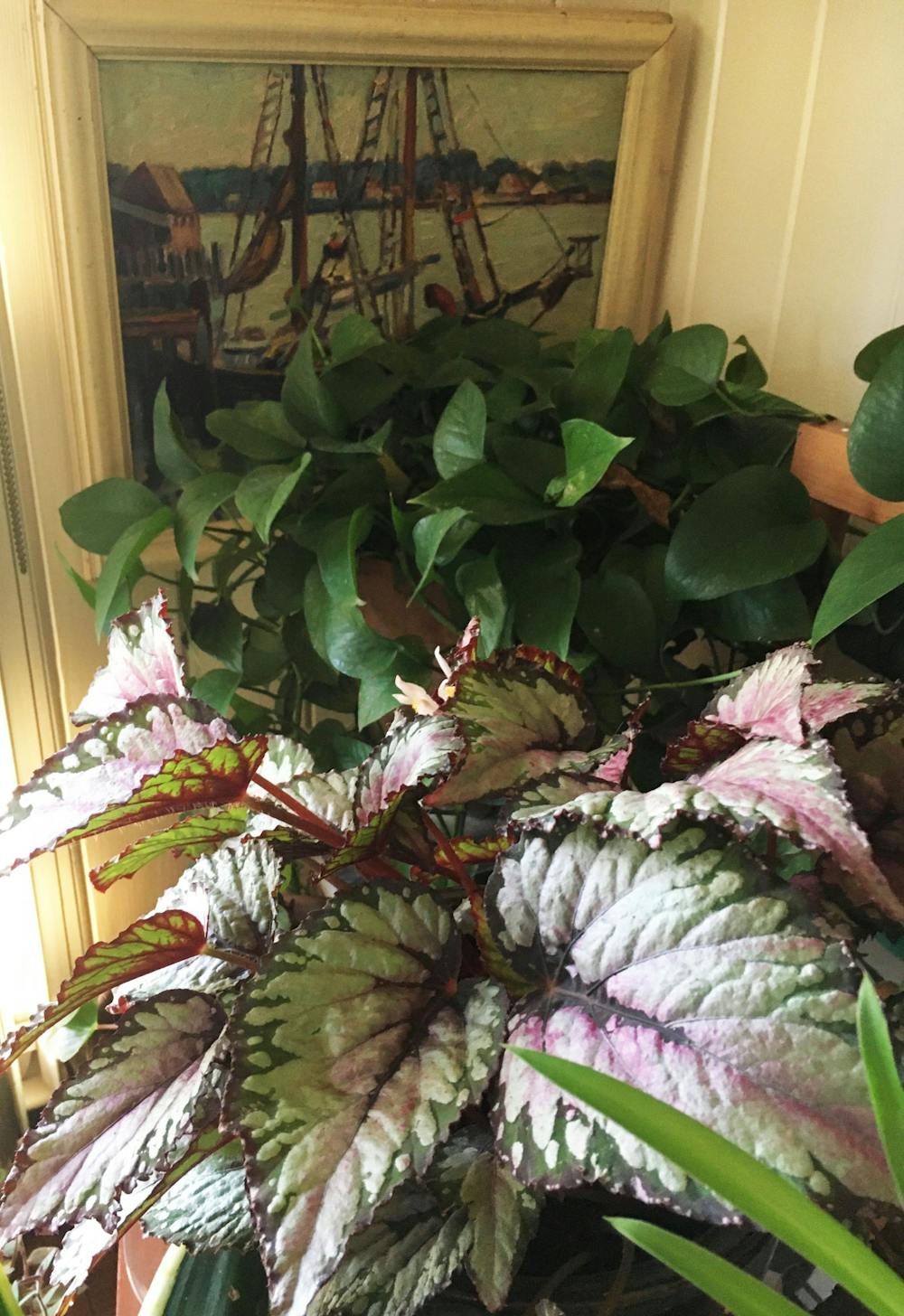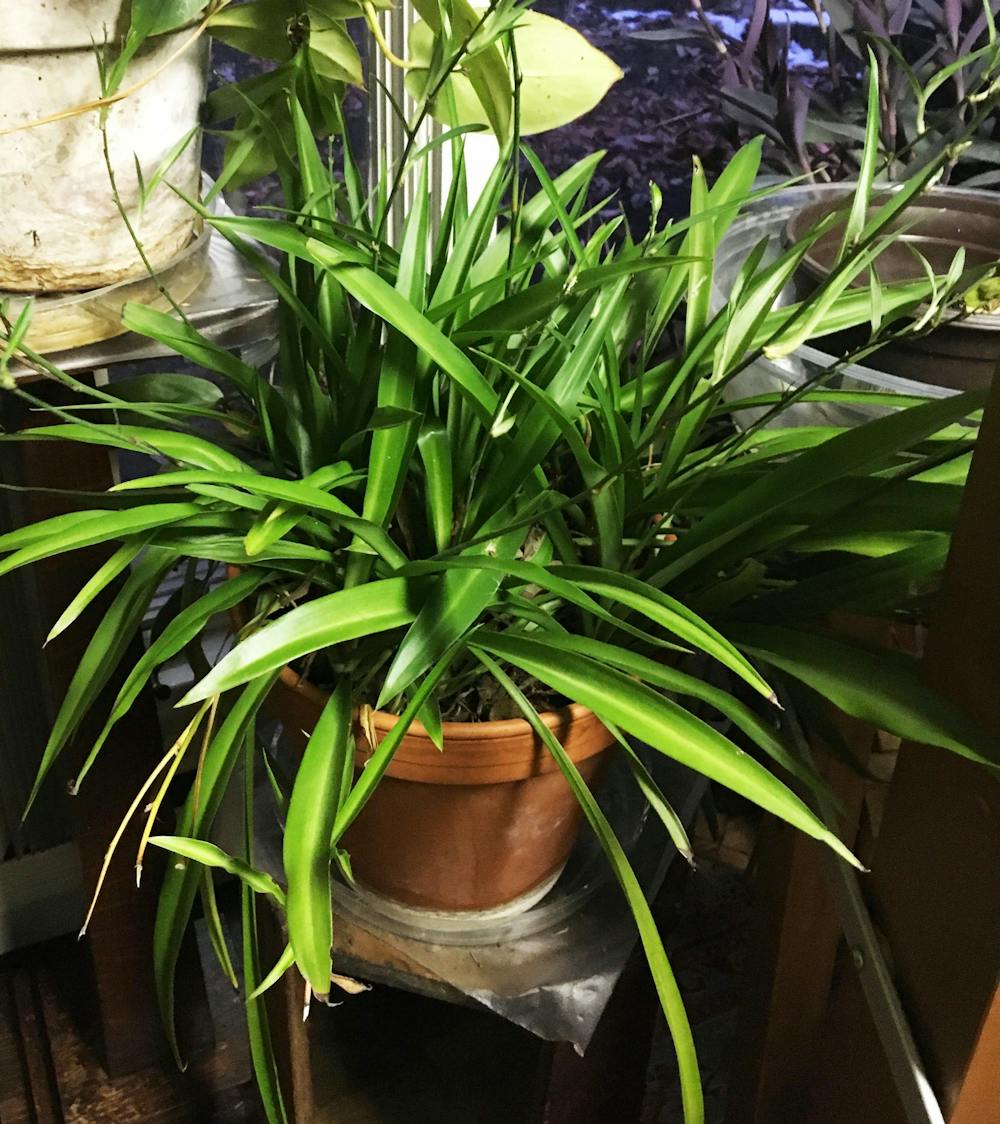After graduating from Ball State, Ann Heintzelman and her husband were looking for their first home when her grandmother gifted her three 20-year-old tropical plants — a snake plant, a spider plant and a philodendron.
Heintzelman’s plants all have a story, she said, and she considers them as part of her family. In the 1990s, her philodendron survived when her garage accidently caught on fire one Fourth of July. Her snake plant is now 5 feet tall, planted in a pot that weighs nearly 70 pounds.
Currently, Heintzelman’s sunroom in her home is filled with nearly 50 plants, including the ones her grandmother gave her nearly 35 years ago.
Heintzelman shares her plant family with others as she uses cuttings from her now 50-year-old plants to give away new plants each year between August and October.
“[A spider plant] looks like giant grass, and every now and then, a chute will come off, and a small baby [plant] will be growing on the end of the chute,” Heintzelman said. “It almost looks like a spider on the end of the stem. Break off that new chute, plant it in some soil, and it'll start a brand new plant.”
As an art teacher at Daleville Elementary School, Heintzelman has, for the past 10 years, filled up a box with 20 to 25 plants to place in the school's teacher’s lounge to let her coworkers have first dibs. Then, she brings her “babies” to her classroom for her students to take home.
“If a kid seems interested, I'll say, ‘Well, if your parents let you have a plant, I can give you one of those,’ and oh my goodness, their eyes light up. It’s like they’ve got a new friend,” Heintzelman said. “I love giving [plants] to young people because maybe they've never had a plant before, and maybe this will start a whole new [interest] with them, too.”

Ann Heintzelman, a Ball State alumna, keeps nearly 50 plants in her sunroom. One of her plants is an Angel Wing Begonia that she takes cuttings to give away to her art students. Recently, a grandmother of one of her former students came to get another one of her Angel Wing Begonias, and Heintzelman says it’s cool that people know her as the plant person. Ann Heintzelman, Photo Provided
Heintzelman first discovered she could start new plants with cuttings after cutting a leaf off of an African Violet, which one of her childhood classmates gave to her before moving away to Oklahoma. Heintzelman placed the leaf in soil, watered it regularly and watched it develop new roots, stems and leaves. Eventually, she had nearly 15 African Violets in her bedroom.
“It's one of those miracles of nature that I grew in love with as a kid and never got tired of it,” Heintzelman said.
While Heintzelman has always been an artsy person, she said, science is her second love. Heintzelman’s parents would take her and her siblings to art galleries and do at-home science experiments, like planting seeds.
“I was allowed to have my own garden at a young age,” Heintzelman said. “There was a big family garden, and then my dad carved out a little circular area in the backyard and said, ‘Now, this is your patch, Ann. What would you like to plant here?’ He really instilled a love for gardening and growing things.”
When Heintzelman posted photos of her plants in September 2020 to give away on the “Indiana Backyard Gardeners” Facebook group, Ashley Nixon, a stay-at-home mom and co-founder of The Salem Pie Company in Daleville, Indiana, reached out to Heintzelman and expressed an interest in her snake plants.
After receiving her snake plant from Heintzelman, Nixon named it Sylvia. Earlier in January 2021, Nixon sent photos of Sylvia to Heintzelman, saying how much of a great addition her new snake plant was to her family.
“I think it brings a little zen into our very weird lives right now,” Nixon said. “I’m very happy that becoming a plant mom came from quarantine.”
Keely Harra-Shepard also saw Heintzelman's post about her houseplants in the Facebook group. Shepard said she picked out a spider plant, a snake plant and three Tradescantias.
Shepard said Heintzelman helped feed her “lifelong plant obsession.” Now, Shepard has a full-time gardening and houseplant business, Sunhouse Horticultural and Home, where she sells seeds, heirloom vegetables and flowers from her garden.
“When I look at my plants, I feel happy — I love to see all the different colors and forms, how much some have grown for me over decades of care,” Shepard said. “When my health was suffering a few years ago, it was my kids and my plants that got me going. I saw my plants starting to die, and it scared me. I hope my love of plants helps my children love plants and the earth, too.”

Ann Heintzelman, a Ball State alumna, received a philodendron from her grandmother 35 years ago. Some philodendrons can produce a sugary liquid that attracts ants, which can protect the plant against pests. Ann Heintzelman, Photo Provided
Because Heintzelman spent a lot of time with her grandmother when she was younger, Heintzelman said she now feels a connection to her grandmother through her plants. For nearly six years of her childhood, her grandmother was in her house nearly every day. When Heintzelman was in fourth grade, her mother went back to work as a newspaper advertiser. Because Heintzelman’s grandmother lived on the same block, she would look after Heintzelman and her siblings when they got home from school until dinnertime.
Heintzelman’s favorite memories with her grandmother were when they spent time together in the kitchen. Her grandmother was a farmer’s wife, so she would “rustle up a great, big breakfast” for her family and neighbors.
Heintzelman said she still remembers when her grandmother said to her one day, “Annie, have you ever made jelly? Let's go to my garden and get some raspberries, and I'll teach you how to make jelly.”
The process was complicated but magical, Heintzelman said, because she ended up with a wonderful jelly made from fruit grown in her grandmother’s backyard. Remembering small but important memories like this, Heintzelman said, are how she still feels connected to her family members who have died, like her mother and grandmother.
“Many of us learn to cook from our grandparents or parents, and I'm so glad that she taught me not just how to cook, but to make pie crust and jelly,” Heintzelman said. “[These memories] seem like small gestures or experiences, and [you realize] how important those are later in your life, especially after they've left this world. [My grandmother] was born in 1901, and she lived to be 99. By giving those [plant cuttings] away, I’m sharing who she was and who I am with others.”
For anyone interested in becoming plant parents, Heintzelman said, jump in and give it a go.
“Don't be afraid to try — Grandma told me that philodendron is hard to kill,” Heintzelman said. “Buy a plant that looks interesting to you, or, if you're lucky enough, get one free from somebody. For most of us, plants bring a room to life. If it’s possible, try to have at least one plant someplace in your home because it adds life to your home and vibrancy.”
Contact Sumayyah Muhammad with comments at smuhammad3@bsu.edu or on Twitter @sumayyah0114.





